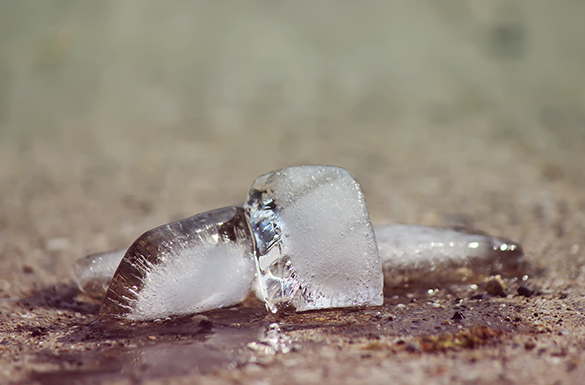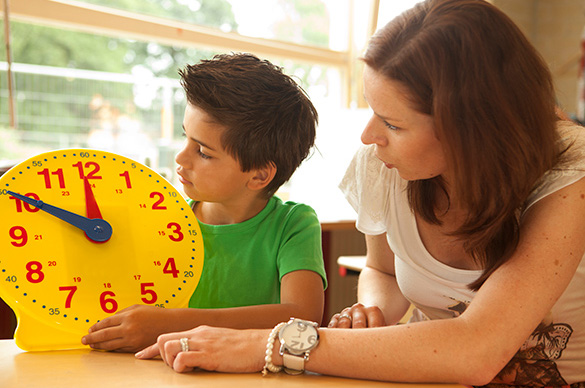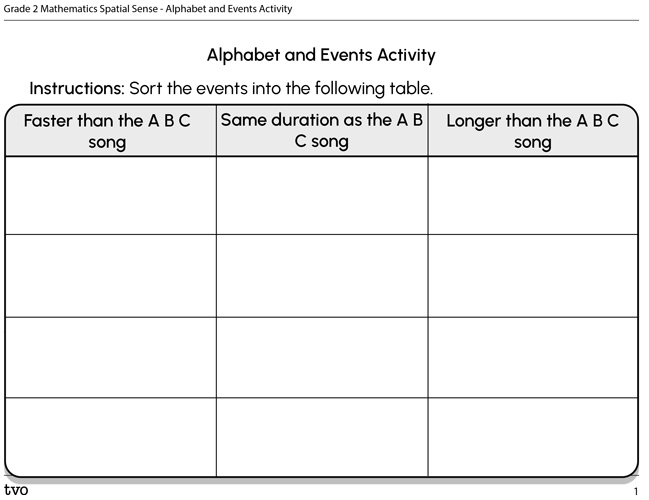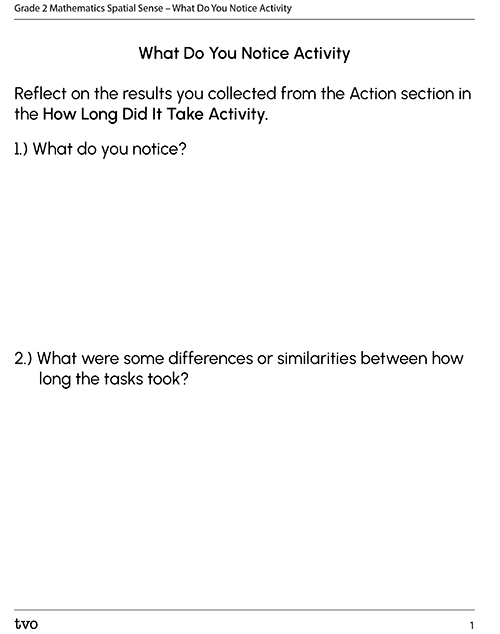Minds On
Which is longer?
Explore the following pairs of events and decide which event might take longer.
Pair 1: An ice cube melting in the sun or going down a slide?


Pair 2: Bouncing a basketball once or a lunch break?


Brainstorm
Let’s think!
After exploring the pairs of events, decide which event might take longer:
- Pair 1: An ice cube melting in the sun, or going down a slide?
- Pair 2: Bouncing a basketball once, or a lunch break?
Reflect on the following questions:
- How could you measure how long each event takes?
- What units could you use? What tools could you use?
- Could you measure how long each event takes using units other than seconds, minutes, or hours?
Record your ideas in your notebook or another method of your choice.
Action
Standard and non-standard units
What are some standard units of time a clock uses?
Press the arrows below to explore the standard units of time a clock uses.
Seconds are the smallest unit of time.
You can use seconds to measure short tasks, such as drinking a sip of water.
Minutes are the second largest unit of time. A minute is 60 seconds in length.
You can use minutes to measure tasks such as brushing your teeth.
An hour is the largest unit of time. There are 60 minutes in an hour.
Activities that take about an hour include gym class, sports lessons, or baking cupcakes.
Which unit?
Select the correct answer, then press ‘Check Answer’ to reveal how you did.
Measuring tools
What tools could we use that measure time using seconds, minutes, and hours?


We can use a clock or a stopwatch to measure time.
But what about if we do not have a clock or a stopwatch? What can we use to measure how long something takes, or the duration?
Press ‘Let’s Check!’ to reveal what to use to measure when you don’t have a clock or stopwatch.
Using non-standard units is another way to keep track of duration, or how long something takes.
Examples of a non-standard unit: the drip of a faucet, claps, stomps, the beat of a metronome, or a sand timer.
When measuring time using a non-standard units of time, we need to be sure that the units repeat at the same speed and follow the same pattern.Metronome and sand timers

A metronome is a tool which is used to keep count.
The metronome has a bar that swings back and forth, and we can count every beat.
A sand timer is a tool used to keep track of time.
When flipped upside down the sand will fall slowly through a small opening from the top of the timer to the bottom. When the sand is at the bottom of the timer, that means a set amount of time has passed.
Let’s sing!
Explore the following A B C song.
A B C Song
Now, let’s decide if the following events can be completed:
- before the song ends
- in the same amount of time as the song
- or longer than the song to complete
Events:
- repeat your name 5 times
- fill a cup with water
- eat lunch
- get ready for school
- bounce a ball once
- open a marker
- write a sentence
- wash your hands
- make a tall tower using blocks
- enjoy a movie
Complete the Alphabet and Events Activity in your notebook or using the following fillable and printable document. You can also use a method of your choice.

Press the Activity button to access the Alphabet and Events Activity.
Activity (Open PDF in a new tab)Timed activities
Explore the following video entitled “Washing Hands” to learn more about how to properly wash your hands.
This video was about washing hands. It takes about 1 minute and 10 seconds for Vikram to wash his hands.
Non-standard units of time
Now, let’s discover how long it takes to complete this task using a non-standard unit of your choice, such as claps, stomps, arm raises, the beat of a metronome, or the dripping of a faucet.
When counting how long a task takes using a non-standard unit, be sure to keep a steady pattern.
For example, if you choose to keep track using claps, you will need to follow the same pattern the whole time. You would need to clap, stop, clap, stop, clap, stop, at the same speed throughout the whole task.

Clap Pattern
Task: How long did it take?
After exploring the video and non-standard units of time, let’s examine how long it took to complete the task of hand washing using a non-standard unit of your choice.
Consider the following instructions:
- Decide when you think the task starts and when the task ends.
- When the task starts: This is when you start counting using your non-standard unit.
- When the task is finished: This is when you stop counting and record your time.
- Record how long it takes to complete each task.
Record your ideas in your notebook or another method of your choice.
Now choose a task of your own and time it using a non-standard unit of time of your own choosing.
Use the instructions just like you did with the hand washing video.
Consolidation
What do you notice?

Reflect on the results you collected from the Action section in the How Long Did It Take Activity.
- What do you notice?
- What were some differences or similarities between how long the tasks took?
- Which activity took the longest amount of time? How do you know?
- Would the time be different if you used a different non-standard unit to count how long it took for each activity?
Brainstorm
Estimating
Think of a task that does not take much time to complete.
Estimate how long it would take using the non-standard units you used before.
How do you know?
Record your ideas in a notebook or a method of your choice.
Reflection
How do you feel about what you have learned in this activity? Which of the next four sentences best matches how you are feeling about your learning? Press the button that is beside this sentence.
I feel...
Now, record your ideas about your feelings using a voice recorder, speech-to-text, or writing tool.
Press ‘Discover More’ to extend your skills.
Discover MoreExplore the following video entitled “Sun Time” to learn more about a sun dial, and how it uses shadows cast by the sun to tell time.
